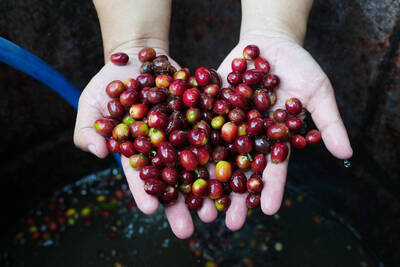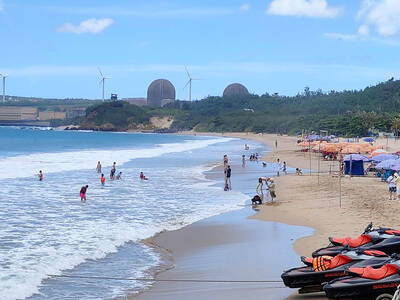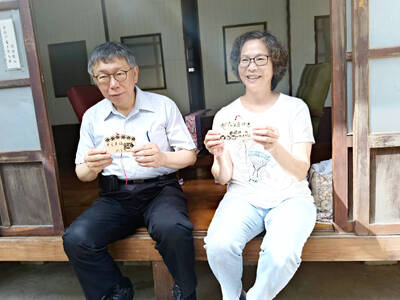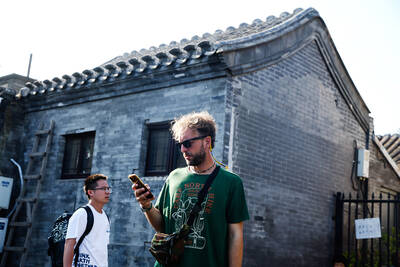The small space on Yunhe Street near Shida night market that used to house Maryjane before the pizzeria’s recent move has been given a makeover — or rather, a make-under. It’s now home to a spartan noodle house, but instead of the usual beef noodles found in the night market, Lichiang (麗江南洋風味麵食館) takes taste buds on a trip to Southeast Asia.
The restaurant’s menu is inspired by cuisine from southeast Asian countries, as well as Yunnan, a province in China that neighbors Vietnam, Laos and Myanmar. Most of its noodle dishes are prepared from a choice of regular flour noodles, hefen (河粉), aka flat rice noodles, or babasi (巴巴絲), thinner rice noodles with a softer texture that are used in Vietnamese and Thai cuisines.
Lichiang’s signature dish is its Yunnan noodles (雲南製涼麵, NT$70), or cold flour noodles topped with spicy nuoc cham sauce, cilantro, julienne cucumber and carrot slices, and neat strips of marinated and barbecued pork. Crisp slivers of sauteed garlic balance the tangy nuoc cham and add some texture to the heap of noodles. The pork was sliced so thinly that it was easy to forget once I had mixed up all the ingredients, but the hint of meat made the dish heartier and more interesting than other versions of cold noodles.
On a separate visit, we ordered the curry chicken dry noodles with babasi (咖哩雞乾, NT$70) and barbecue pork with flour noodles (叉燒乾, NT$70). The curry chicken was the superior of the two, far outshining the bland pork noodles, which actually did not have that much meat, or even much of pork flavor. The latter was topped with cabbage, chopped scallion and dried ramen noodles, none of which managed to make the dish any more memorable. The curry chicken, on the other hand, was plump and juicy. I chose the babasi over the other two noodle options because its soft rice strands are supposed to soak up the curry flavor more effectively, and that was indeed the case — good thing, too, because the curry was very gentle, neither pungent nor spicy. The curry chicken noodles were also topped with cabbage and dried ramen noodles that were surprisingly effective at adding some crunchy fun to the dish.
Lichiang’s decor is bare-bones — a fact that’s good-naturedly pointed out in a giant advertising poster on the front door. Its only wall decorations are two picture menus and some tissue dispensers. The prices are low, however, and portions surprisingly large. Service is brisk, especially for cold dishes (my Yunnan noodles took only about two minutes to arrive).
The restaurant has a take-out special: if you order 10 meals to go, the 11th is free. Cans of soda (NT$20 each) and mango, tamarind or coconut juice (NT$30) are also available.

Climate change, political headwinds and diverging market dynamics around the world have pushed coffee prices to fresh records, jacking up the cost of your everyday brew or a barista’s signature macchiato. While the current hot streak may calm down in the coming months, experts and industry insiders expect volatility will remain the watchword, giving little visibility for producers — two-thirds of whom farm parcels of less than one hectare. METEORIC RISE The price of arabica beans listed in New York surged by 90 percent last year, smashing on Dec. 10 a record dating from 1977 — US$3.48 per pound. Robusta prices have

A dozen excited 10-year-olds are bouncing in their chairs. The small classroom’s walls are lined with racks of wetsuits and water equipment, and decorated with posters of turtles. But the students’ eyes are trained on their teacher, Tseng Ching-ming, describing the currents and sea conditions at nearby Banana Bay, where they’ll soon be going. “Today you have one mission: to take off your equipment and float in the water,” he says. Some of the kids grin, nervously. They don’t know it, but the students from Kenting-Eluan elementary school on Taiwan’s southernmost point, are rare among their peers and predecessors. Despite most of

The resignation of Taiwan People’s Party (TPP) co-founder Ko Wen-je (柯文哲) as party chair on Jan. 1 has led to an interesting battle between two leading party figures, Huang Kuo-chang (黃國昌) and Tsai Pi-ru (蔡壁如). For years the party has been a one-man show, but with Ko being held incommunicado while on trial for corruption, the new chair’s leadership could be make or break for the young party. Not only are the two very different in style, their backgrounds are very different. Tsai is a co-founder of the TPP and has been with Ko from the very beginning. Huang has

A few years ago, getting a visa to visit China was a “ball ache,” says Kate Murray. The Australian was going for a four-day trade show, but the visa required a formal invitation from the organizers and what felt like “a thousand forms.” “They wanted so many details about your life and personal life,” she tells the Guardian. “The paperwork was bonkers.” But were she to go back again now, Murray could just jump on the plane. Australians are among citizens of almost 40 countries for which China now waives visas for business, tourism or family visits for up to four weeks. It’s